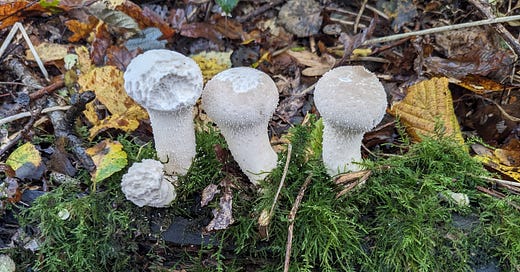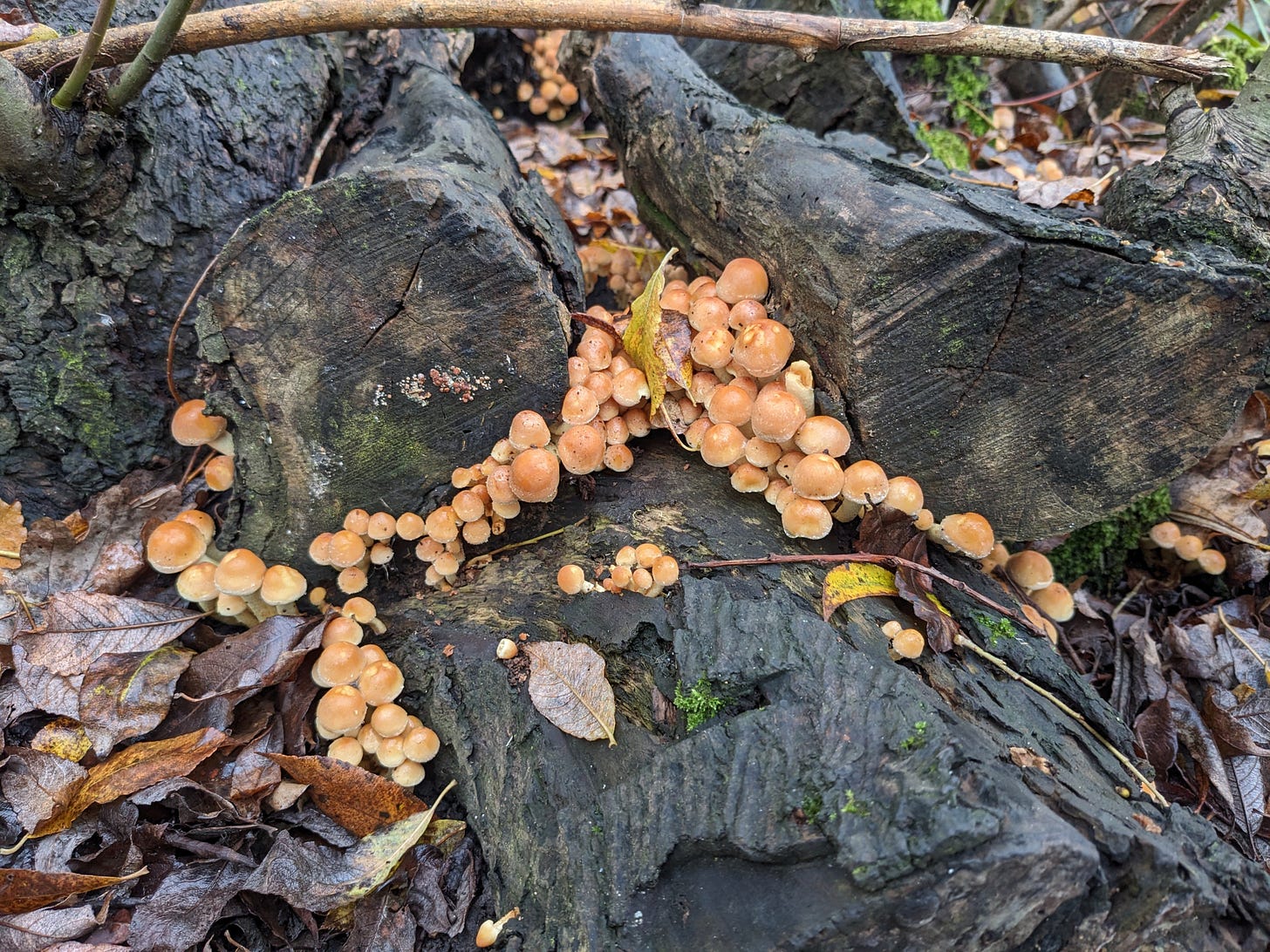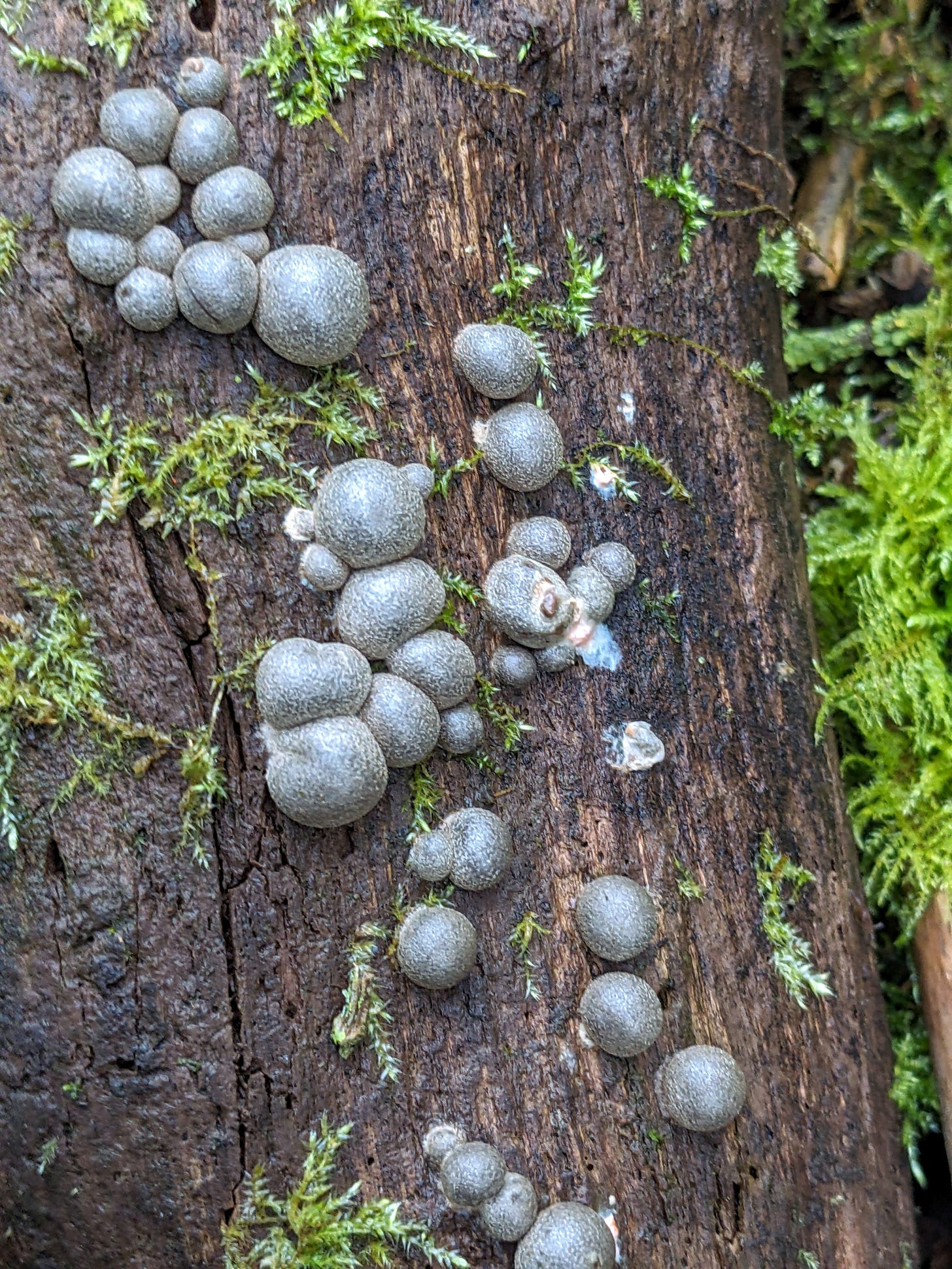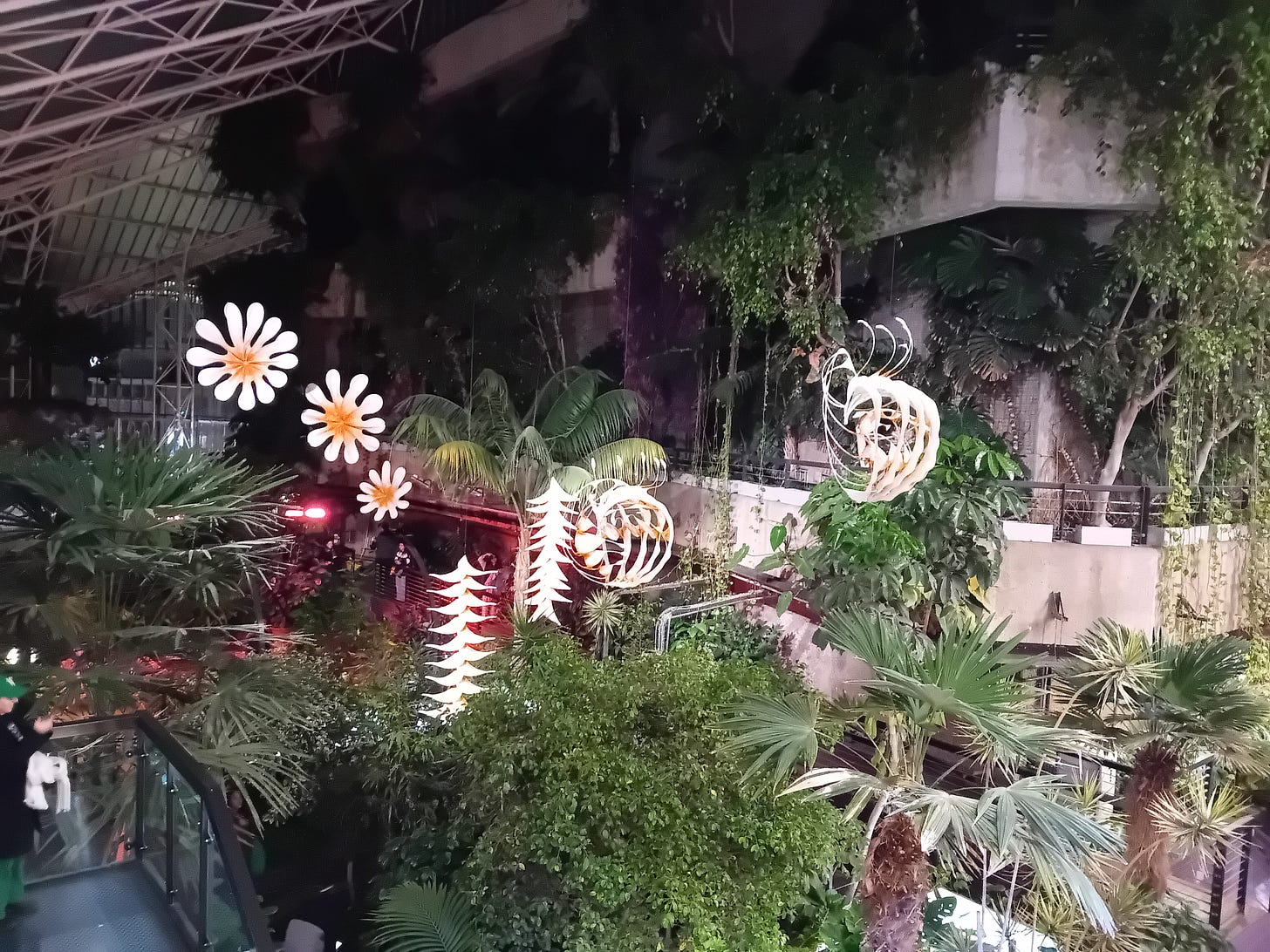All the damp, dreary weather in recent weeks has provided the perfect conditions for fungi to thrive. When I visited King’s Wood last month, I even saw magnificent displays of them sprouting up through the neat front lawns of some of the large houses on the road that leads up to the woods. The recent spell of frosty nights and chilly days obviously didn’t suit them quite so well as those fungi are shrivelled and disintegrating now but as the weather has got warmer and wetter again lots of others have appeared.
Last month, before the cold snap started, I went on a Fungi Foray organised by the Friends of South Norwood Country Park. With the help of an expert guide, we discovered dozens of different species, hidden among the leaf mould and bursting out of the sides of trees and rotting logs. We looked at some of the species we found through loupes (small hand lens) so we could see them in more detail. When our guide described one as looking like a shaggy carpet, I couldn’t imagine what he meant until I got a chance to look at that specimen myself, and then there it was. As with so many parts of the natural world, there is so much more to fungi when you take time to pay close attention to them.
I’ve volunteered in the Country Park many times over the years, but this was a whole new way of seeing a place I thought I knew well. It was fascinating to learn more about the different species and to appreciate the huge variety that exists, even within the same species. We learnt that the large pinky-grey blobs that one of our group nicknamed Alien’s Eggs were in fact the same species as the very different looking, and much smaller, orange blobs nearby but at a different stage in their life cycle. But then just to add to the variety we were told that these were not actually fungi but a species of slime mould called Wolf’s Milk (Lycogala epidendrum).
A few days after the walk, I received an email with a list of the species we found – 32 in total including Chondostereum purpureum (Silver-leaf Fungus), Daedaleopsis confragosa (Brushing Bracket) and Lacrymaria velutina (Weeping Widow). Only one or two of them, such as Sulphur Tuft (Hypholoma fasciculare), are ones that I would have recognised myself. Many are listed only by their scientific names, and the list of Latin words reads like a kind of spell.
For centuries people were mystified by the sudden appearances of lines or circles of mushrooms and could think of no other explanation than the existence of fairies or some form of witchcraft. We now know that there are more practical and less fantastical reasons behind such events and that what we see above the surface are only the fruiting bodies of the fungi. They often grow along the line of a particular feature such as a tree root from which they are drawing nutrients and a ring is formed by fungi moving out from a central point as they use up all the nutrients around them. What would our ancestors have made of the recent discovery that trees and plants share nutrients – and can even communicate - via the mycelium, the network of thin threads formed from the underground parts of fungi, in a phenomenon now often referred to as the “wood wide web”?
Although we use words like fruiting when talking about fungi, they are in fact more closely related to animals than plants. Historically they were included in the plant kingdom because they grow out of the soil, but now they are placed in their own kingdom. (And slime moulds are in yet another completely separate kingdom made up of single-celled organisms, called protists). But when we refer to fauna and flora, we rarely include fungi, that third huge kingdom beginning with f. Perhaps it’s because we rarely do, that we tend to overlook the huge importance of fungi. And perhaps because it’s often associated with death and decay rather than regeneration, the vital role fungi play in recycling other organisms seems to be very under-valued. Or perhaps we overlook their significance simply because so much fungal growth goes on out of sight below ground.
The scientist, Merlin Sheldrake, argues that we are in danger of taking a plant-centric approach to fungi, citing the concept of the Wood Wide Web, and the way it focuses on fungi’s role in supporting plant life. In his book, Entangled Life, he describes how fungi are being used to tackle modern environmental challenges such as reducing pollution and as an alternative to plastic but makes the point that although humans may feel we are using fungi for our own ends, we are in fact doing exactly what is in their interests by providing them with the stuff they need to grow and helping them to spread around the world. According to Sheldrake: Everything changes when we see fungi as active participants. It’s an intriguing thought.
To finish…
…a few things I’d like to share:
Entangled Life: How fungi make our worlds, change our minds, and shape our futures by Merlin Sheldrake. This book makes it clear just how much we have underestimated fungi. Writing in an accessible and engaging style, Sheldrake provides a very thorough, and deeply engrossing, overview of the multiple ways fungi contribute to life on earth and have influenced how we live today. He also highlights that there is still a lot more that we don’t yet know about fungi. We are only just beginning to understand the intricacies and sophistications of fungal lives.
Pathologies, an essay by Kathleen Jamie (included in her book, Sightlines, and also available online). Like many of Jamie’s essays, Pathologies illustrates the importance of taking the time to look at things properly and the value of seeing the beautiful and interesting in all parts of the natural world. In this essay she visits a pathology lab and describes the tiny details revealed when viewing cancerous cells and bacteria through a microscope, comparing what she sees to a landscape, …a bright and pretty bird’s eye view of an ordered, if unusual land. The experience makes her reconsider her understanding of nature to incorporate this nature within. Nature we’d rather do without.
Cloud songs on the horizon by Ranjani Shettar. If you’re in London, or planning to visit over the next few months, I recommend a trip to the Barbican to see the show that’s currently on in the Conservatory. Shettar has handcrafted huge sculptures of flowers, leaves and other objects inspired by nature and these now hang suspended from the roof of the Conservatory which is worth seeing anyway, being an oasis of greenery in an area dominated by steel and concrete. We visited in the evening and the lighting made both plants and sculptures particularly impressive. It’s open until the end of March and is free to visit but you need to book tickets in advance.







